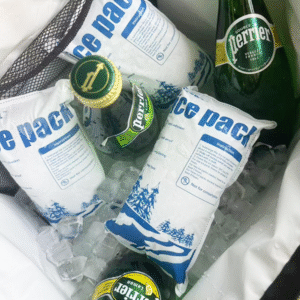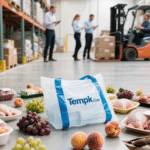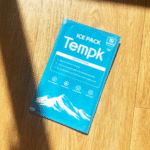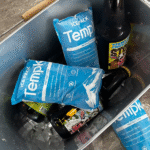How Does Pharma Cold Chain Logistics Ensure Drug Safety?
Pharma cold chain logistics — the process of transporting and storing medications under strict temperature control — keeps life saving drugs safe and effective. Without controlled temperatures, vaksin, biologics and gene therapies can degrade or become dangerous. To help you navigate this complex field, this guide explains why temperature controlled logistics are essential, outlines best practices, highlights new technologies and explores the latest trends for 2025. Pada akhirnya, you’ll know how to protect your temperature sensitive products and comply with evolving regulations.

Why is pharma cold chain logistics critical for vaccines, biologi dan terapi gen?
What temperature ranges and equipment are required for different drug categories?
How can IoT sensors, AI analytics and smart packaging improve visibility and reduce risk?
Apa itu 2025 trends in pharma cold chain logistics, including market growth and sustainability?
How can you select the right logistics partners and stay compliant with global regulations?
What Makes Pharma Cold Chain Logistics So Important?
Precise temperature control preserves drug potency. Vaksin, biologics and advanced therapies lose efficacy if they fall outside recommended storage ranges. The CDC advises that refrigerators maintain 2 °C–8 °C (36 °F–46 °F) and freezers maintain −50 °C to −15 °C (−58 °F to +5 ° f). Similar guidance from pharmacy cold chain experts notes that most vaccines and refrigerated medications require 2 °C–8 °C, frozen biologics need −50 °C to −15 °C and ultra cold storage demands −90 °C to −60 °C. Deviations can rapidly degrade potency or render products toxic.
Why drug stability depends on temperature
During manufacturing and distribution, active ingredients in biologics are fragile proteins and nucleic acids. Temperature fluctuations accelerate molecular degradation and denature these materials. Misalnya, mRNA vaccines require ultra cold storage (−90 °C hingga −60 °C) to prevent RNA strands from breaking down. Even “room temperature” medications have strict limits (20 °C–25 °C) with short term allowances. By maintaining defined ranges, cold chain logistics ensure that patients receive safe and effective doses.
Impact on public health and costs
Ensuring temperature integrity protects patient safety and reduces costly waste. Cold chain deviations can cause vaccine potency loss, leading to revaccination and public health risks. Pharmacy case studies show that continuous monitoring prevented loss of over US$50 000 in biologics during a heatwave. Sebaliknya, failed cold chain events can result in recalls, reimbursement, legal liability and reputational damage. Sebagai akibat, regulators require detailed temperature logs and validated processes to minimise excursions.
| Kisaran suhu | Contoh Produk | Mengapa itu penting |
| 2 °C–8 °C (36 °F–46 °F) | Vaksin standar (MISALNYA., influensa, HPV), insulin, Antibodi monoklonal | Maintaining this range prevents potency loss and avoids revaccination. |
| –25 °C hingga –15 °C (–13 °F–5 °F) | Frozen biologics and certain vaccines | Freezing preserves structural integrity; warming causes structural damage. |
| –90 °C hingga –60 °C (–130 °F– –76 °F) | Vaksin mRNA, gene therapies and cell therapies | Ultra cold storage prevents rapid degradation and maintains viability. |
| 20 °C–25 °C (68 °F–77 °F) | Room temperature drugs | Even non cold products have strict limits; heat can reduce potency. |
Practical tips for safeguarding drug integrity
Use pharmaceutical grade equipment. Household refrigerators have temperature fluctuations; choose purpose built units for 2 °C–8 °C or freezers for −50 °C to −15 °C.
Pantau terus menerus. Install digital data loggers (DDLs) with buffered probes and remote alerts. Calibrate devices regularly and keep certificates on file.
Follow validated packaging protocols. Kontainer yang sudah dikondisikan sebelumnya, avoid overloading and label packages with required temperature ranges.
Plan for the last mile. Use shipping containers validated to exceed transit time and establish rescue protocols to recover misrouted shipments.
Prepare contingencies. Maintain backup power, alternative refrigeration and extra batteries to prevent excursions.
Contoh dunia nyata: A specialty pharmacy implemented digital data loggers with remote alerts. During a summer heatwave, an alarm sounded when a refrigerator reached 9 ° C.. Staff immediately moved inventory to a backup unit, saving over US$50 000 in medications and ensuring uninterrupted patient therapy.
How Do You Build a Reliable Cold Chain for Vaccines and Biologics?
Ensuring a robust cold chain involves more than refrigeration. It requires integrated infrastructure, specialised equipment, real time monitoring and regulatory compliance. Contract development and manufacturing organisations (CDMO) invest in temperature controlled suites, cryogenic freezers and validated processes to maintain quality. This section details the core elements of building and maintaining an end to end pharma cold chain.
Integrated infrastructure and equipment
Cold chain operations span storage, penanganan, pengemasan dan transportasi. CDMOs use advanced refrigeration systems, cryogenic freezers and temperature mapping tools to ensure uniform distribution. Sensor berkemampuan IoT, data loggers and remote platforms provide continuous surveillance and immediate alerts for temperature excursions. Validated processes — including controlled rate freezing and quality control protocols — support consistent manufacturing quality.
Process development and manufacturing control
From early stage development, companies establish temperature parameters for raw materials, produk antara dan produk jadi. Biologics manufacturing involves maintaining cell cultures at 36 °C–37 °C, cooling during harvest, storing intermediate pools at 2 °C–8 °C and cryogenically preserving drug substance at −60 °C to −80 °C. Documented temperature management during technology transfer ensures that manufacturing conditions remain consistent across facilities.
Quality control and stability testing
Stability studies require validated chambers set to International Council for Harmonisation (SAYA) kondisi, dengan pemantauan berkelanjutan dan daya cadangan. Separate storage areas for stability samples reduce the risk of cross contamination and enable accelerated and real time stability programs. Temperature excursions can invalidate study data, so redundant systems and thorough documentation are essential.
Inventory management and packaging
Validated thermal packaging protects products during shipment. Wadah terisolasi, phase change materials and active temperature controlled containers maintain required temperatures. Advanced warehouse management systems track location, temperature history and expiry dates while maintaining chain of custody documentation. For last mile delivery, real time tracking and rescue protocols prevent misroutes and delays.
Key considerations and benefits
| Komponen | Pertimbangan utama | Manfaat |
| Continuity | Use validated packaging, real time sensors and rescue protocols to maintain temperature from production to patient | Prevents costly product loss and maintains patient therapy schedules |
| Keberlanjutan | Adopt reusable and recyclable packaging; invest in energy efficient equipment | Reduces waste and appeals to eco conscious stakeholders |
| Kepatuhan | Follow standards like URAC 5.0 dan Praktik Distribusi yang Baik (PDB); define temperature ranges and test packaging | Ensures regulatory adherence and simplifies audits |
Actionable tips for your practice
Develop written cold chain policies. Outline processes, responsibilities and corrective actions. Audit your supply chain regularly to identify weak points.
Train staff and carriers. Educate delivery partners on handling temperature sensitive products and equip them with validated tools.
Berinvestasi dalam keberlanjutan. Reusable materials and eco friendly insulation reduce environmental impact and can lower long term costs.
Document and verify. Simpan catatan suhu, calibration records and evidence of packaging qualification to demonstrate compliance during inspections.
Studi kasus: Researchers reviewed 292 drugs approved between January 2018 and March 2023 and found that 43 % required cold chain storage and 6 % required freezing. Specialty medications experienced last mile errors eight times more often than routine dispensing. By implementing package rescue protocols and training delivery staff, a pharmacy chain reduced distribution errors and maintained product integrity.
How Technology Is Transforming Pharma Cold Chain Logistics in 2025
The next generation of pharma cold chain logistics is more connected, intelligent and responsive. Advances in IoT sensors, Analisis berbasis AI, smart packaging and modular ultra cold storage are reshaping the industry. These tools deliver real time visibility, enable predictive maintenance and support agile responses to disruptions.
IoT enabled monitoring and real time data
Smart sensors monitor temperatures, kelembaban, kejutan dan lokasi, transmitting data to cloud platforms where anomalies trigger instant alerts. IoT connected storage units and automated cold storage systems provide real time dashboards, remote access and excursion logs. By analysing continuous data streams, AI algorithms can predict equipment failures or route delays before they occur, memungkinkan intervensi proaktif.
Smart packaging and modular cold storage
Emerging packaging solutions incorporate built in temperature loggers, QR codes and tamper evident seals. These “smart packages” record the temperature history from manufacturer to patient. Modular freezer units allow logistics providers to scale ultra cold capacity (–20 °C, –40 °C or –80 °C) based on demand. Combining modular storage with IoT systems supports rapid expansion without compromising reliability.
AI driven analytics and predictive maintenance
Machine learning models analyse temperature data, transit times and environmental conditions to forecast risk. Misalnya, if a route is prone to temperature excursions during summer, AI can suggest alternative routing or additional insulation. Predictive maintenance tools monitor compressor performance, door openings and power consumption to schedule repairs before breakdowns, mengurangi waktu henti yang tidak direncanakan.
Integration with broader logistics strategy
Forward thinking providers integrate cold storage into end to end logistics plans. Direct to site coordination reduces intermediate stops and risk exposure, while customs prepared documentation speeds border crossings. Automated distribution centers with validated thermal transport assets ensure seamless handoffs to final mile carriers. Enhanced visibility across warehousing, transport and delivery enables rapid response to disruptions.
Industry drivers and innovation trends
Several forces are accelerating cold chain innovation:
Biologics boom. Lebih 40 % of newly approved drugs in 2024 were biologics, many requiring cold or ultra cold storage.
Global distribution expansion. COVID era infrastructure raised expectations for pharmaceutical distribution worldwide.
Stricter compliance. Regulators like the FDA and EMA demand full data visibility across storage and transit.
Need for agility. Manufacturers are outsourcing logistics but expect providers to adapt quickly to changing volumes.
Contoh: A biologics firm deployed IoT sensors and AI analytics across its supply chain. When a shipment of monoclonal antibodies encountered traffic delays, the system predicted a potential temperature excursion. The logistics team rerouted the shipment through a faster route and added dry ice at a midway hub, preventing spoilage and protecting patient supply.
Ensuring Compliance, Sustainability and Risk Management
Pharmaceutical cold chain logistics operate within a stringent regulatory environment. Praktek Distribusi yang Baik (PDB), Praktek Manufaktur yang Baik (GMP) and national guidelines all require validated processes, documentation and monitoring. Pada saat yang sama, stakeholders demand sustainable operations that minimise environmental impact.
Regulatory frameworks and accreditation
Global regulators like the FDA, EMA and WHO require adherence to GDP and GMP. Standards such as URAC 5.0 call for evidence based temperature ranges, qualification testing and documentation of outcomes. The CDC’s Pink Book emphasises that refrigerators should maintain 2 °C–8 °C and freezers −50 °C to −15 °C, with thermostats set at factory midpoints to reduce excursions. Facilities should develop written standard operating procedures, train staff annually and appoint vaccine coordinators to oversee compliance.
Sustainability and circular economy
Environmental concerns are reshaping cold chain logistics. Industry surveys show that 77 % of supply chain leaders prioritise sustainability. Reusable and recyclable packaging materials, biodegradable mailers and plant based insulation reduce waste and appeal to eco conscious consumers. Upgrading facilities with energy efficient refrigeration and solar panels lowers carbon footprints while improving operational resilience.
Manajemen risiko dan perencanaan kontinjensi
Risk management encompasses preventive and corrective measures. Preventive strategies include continuous monitoring, pemeliharaan prediktif, and route optimisation. Corrective actions involve emergency procedures for power failures, equipment malfunctions or natural disasters. SOPs should specify who to notify, how to handle exposed products and how to document excursions. Backup generators, redundant compressors and alternative storage units are essential safeguards.
Decision tools and self assessment
To reduce human error, implement interactive tools that guide staff through storage checks and packaging decisions. Misalnya, a decision tree could prompt users to select the product type (vaksin, biologic or gene therapy) and recommend the appropriate temperature range, packaging materials and monitoring devices. Self assessment checklists help facilities evaluate readiness, identify gaps and track continuous improvement over time.
Skenario praktis: A mid size hospital used a self assessment tool to review its vaccine storage. The tool flagged that the facility lacked an emergency generator. After installation, the hospital maintained temperature control during a regional power outage, preventing waste and ensuring patient safety.
2025 Market Outlook and Emerging Trends
The pharma cold chain industry is experiencing rapid growth. According to logistics experts, the global cold chain logistics market was valued at US$293.58 billion in 2023 and is projected to grow from US$324.85 billion in 2024 menjadi US$862,33 miliar pada 2032, dengan tingkat pertumbuhan tahunan gabungan (CAGR) dari 13 %. Healthcare focused reports estimate that the healthcare cold chain logistics market will reach US$65.14 billion in 2025 and expand to US$137.13 billion by 2034 pada CAGR sebesar 8.63 %. Amerika Utara saat ini mendominasi pasar, while Asia Pacific is poised for the fastest growth.
Tren-tren utama sedang terbentuk 2025 dan seterusnya
Stronger visibility through software. Investments in supply chain visibility tools provide real time tracking and predictive analytics, enhancing decision making.
Kategori produk baru. The rise of plant based foods, personalised nutrition and novel biologics introduces new temperature requirements and logistics complexities.
Upgraded storage facilities. Aging infrastructure is being replaced with automated, energy efficient warehouses. New facilities incorporate multiple temperature zones and sustainability features.
Better distribution networks. Strategic facility location near production sites and consumers reduces transit time and risk.
Expansion into emerging markets. Infrastructure investments in Africa, Latin America and Southeast Asia are improving access to temperature sensitive medicines and vaccines.
Market insights and growth drivers
The COVID 19 pandemic accelerated investment in cold chain infrastructure, terutama untuk vaksin mRNA. Population growth, rising prevalence of chronic diseases and adoption of biologics continue to drive demand. Sementara itu, regulatory scrutiny and consumer expectations for sustainability prompt companies to invest in greener technologies. Geopolitical events and trade disruptions can affect transport capacity, underscoring the need for resilient supply chains.
Tip: Evaluate partners’ capacity expansion plans and sustainability initiatives. A provider with modular ultra cold storage and renewable energy can offer both flexibility and environmental responsibility.
Cara Memilih Mitra Logistik Cold Chain yang Tepat
Selecting a reliable partner is critical. Here are factors to consider:
Regulatory expertise. Ensure the provider understands GDP, GMP, FDA and EMA requirements and maintains compliance documentation.
Technology capability. Look for IoT connected monitoring, predictive analytics and real time visibility dashboards.
Infrastructure flexibility. Partners should offer multi temperature zones, modular storage and emergency power systems.
Sustainability commitment. Evaluate the use of reusable packaging, renewable energy and carbon reduction strategies.
Global reach and responsiveness. Consider geographic coverage, customs expertise and contingency plans for delays or disruptions.
Interview questions for potential partners
How do you manage temperature excursions? What is your escalation protocol?
What certifications (MISALNYA., PDB, URAC) do your facilities hold?
Can you provide historical temperature data and audit reports?
How do you integrate sustainability into your operations?
How quickly can you scale capacity for new product launches?
Studi kasus: Building a Cold Chain for a Gene Therapy Launch
Situasi: A biotech company planned to launch a gene therapy requiring storage at −80 °C. The therapy was manufactured in the United States and distributed to treatment centers worldwide.
Tantangan: The therapy’s active ingredient degraded rapidly above −60 °C. The company had limited experience with international cold chain logistics and needed to ensure regulatory compliance across multiple jurisdictions.
Solusi:
Modular ultra cold storage. The logistics partner provided scalable −80 °C freezer units at regional hubs, each with backup generators and remote monitoring.
Kemasan cerdas. Each shipment used insulated containers with phase change materials and embedded data loggers to record temperature history. QR codes enabled verification at each handoff.
Real time tracking and analytics. IoT sensors transmitted data to a central dashboard. AI algorithms predicted potential delays and recommended route adjustments.
Regulatory coordination. The partner’s compliance team ensured that shipping documentation met FDA, EMA and local guidelines.
Hasil: The launch proceeded without temperature excursions or regulatory violations. On time delivery rates exceeded 98 %, and the therapy reached patients safely. The company built a scalable framework for future gene therapy launches.
2025 Trends at a Glance
Pertumbuhan pasar: The global cold chain logistics market is projected to more than double by 2032, while healthcare cold chain logistics will exceed US$137 billion by 2034.
Adopsi teknologi: Sensor IoT, AI analytics and smart packaging enhance visibility and predictive capabilities.
Operasi berkelanjutan: Reusable packaging and energy efficient facilities address environmental concerns.
Diverse product mix: Makanan nabati, personalised nutrition and advanced biologics introduce new cold chain demands.
Evolusi regulasi: URAC 5.0 and updated GDP guidelines emphasise evidence based temperature ranges and documentation.
Angka 1. Conceptual infographic illustrating typical temperature ranges for controlled room temperature, didinginkan, frozen and ultra cold conditions in pharma cold chain logistics.
Angka 2. Illustration summarising 2025 trends such as IoT monitoring, analitik AI, kemasan berkelanjutan, upgraded facilities and the boom in biologics.
Pertanyaan yang sering diajukan
- What are the standard temperature ranges for storing vaccines and biologics?
Vaccines and most biologics must be stored between 2 °C dan 8 ° C.. Some biologics require frozen conditions (−25 °C to −15 °C), while mRNA vaccines and gene therapies need ultra cold storage (−90 °C hingga −60 °C). Maintaining these ranges preserves potency and safety.
- How often should temperatures be checked and documented?
The CDC recommends checking and recording minimum and maximum temperatures at least daily, preferably at the start of each workday. Digital data loggers with buffered probes provide continuous monitoring and alarm alerts.
- What is Good Distribution Practice (PDB) Dan mengapa itu penting?
GDP outlines standards for storing, handling and distributing pharmaceutical products. It ensures that medicines maintain quality throughout the supply chain. Compliance involves validated processes, documented temperature ranges and qualified equipment.
- How can small pharmacies afford ultra cold storage?
Small pharmacies can partner with third party logistics providers that offer modular ultra cold storage and shared resources. Renting validated containers or using community vaccine programs can reduce costs while ensuring compliance.
- What are the key sustainability initiatives in cold chain logistics?
Industry leaders are adopting reusable and recyclable packaging materials, investing in energy efficient refrigeration and exploring renewable power sources such as solar panels. These initiatives reduce waste and support corporate social responsibility goals.
- How does IoT improve cold chain visibility?
Sensor IoT memantau suhu, kelembaban dan lokasi secara real time. Data is transmitted to cloud platforms where AI algorithms detect anomalies and predict risks. This continuous visibility enables proactive responses and reduces product loss.
Ringkasan dan Rekomendasi
Pharma cold chain logistics protect the integrity of temperature sensitive drugs and ensure patient safety. Maintaining strict temperature ranges — 2 °C–8 °C for most vaccines and biologics, −25 °C to −15 °C for frozen products and −90 °C to −60 °C for ultra cold therapies — prevents potency loss. Building a reliable cold chain involves integrated infrastructure, peralatan yang divalidasi, continuous monitoring and robust documentation. Emerging technologies such as IoT sensors, analitik AI, smart packaging and modular ultra cold storage enhance visibility and resilience. Sustainability and regulatory compliance are top priorities; kemasan yang dapat digunakan kembali, energy efficient facilities and adherence to URAC 5.0 and GDP guidelines are essential. Pertumbuhan pasar kuat, with cold chain logistics projected to exceed US$862 billion by 2032. Untuk tetap kompetitif, invest in advanced technology, partner with experienced logistics providers and prioritise sustainability.
Langkah selanjutnya yang dapat ditindaklanjuti
Nilai rantai dingin Anda saat ini. Conduct a self audit of equipment, monitoring practices and documentation. Identify gaps and prioritise improvements.
Tingkatkan sistem pemantauan. Implement IoT sensors and cloud based dashboards for real time visibility and predictive analytics.
Latih tim Anda. Provide regular education on GDP, emergency procedures and sustainability practices.
Bermitra secara strategis. Collaborate with logistics providers offering modular ultra cold storage, compliance expertise and sustainability commitments.
Tetap mendapat informasi. Follow regulatory updates and industry trends to adapt your cold chain strategy for future therapies and global expansion.
Tentang tempk
Tempk is a provider of advanced cold chain packaging solutions and temperature monitoring devices. Kami mengkhususkan diri dalam wadah terisolasi, phase change materials and digital data loggers designed for pharmaceutical, bioteknologi dan industri makanan. Kita products undergo rigorous validation and comply with global regulations, helping clients maintain temperature integrity from manufacturer to patient. Dengan fokus pada keberlanjutan, Kami offer reusable and recyclable packaging that reduces waste and supports corporate environmental goals.
Panggilan untuk bertindak: Contact Tempk for expert guidance on building a compliant and sustainable cold chain solution tailored to your specific needs.























